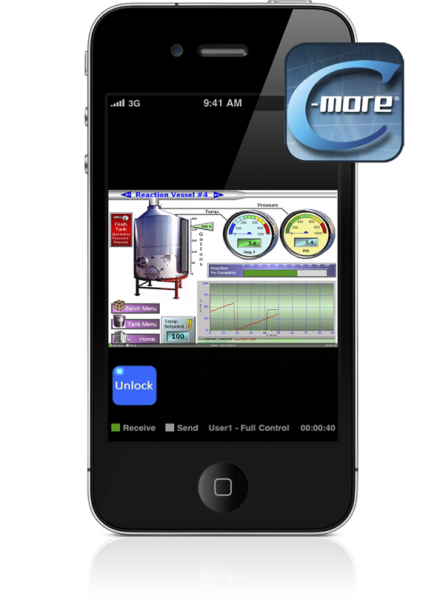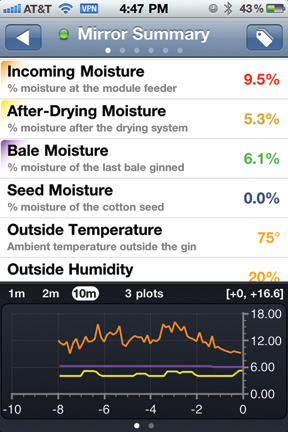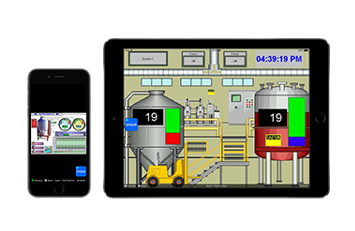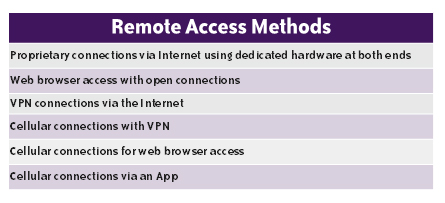Internet and cellular technology make monitoring and control easier than ever.
The automation world, with its distant and often isolated sites, has long sought reliable remote access to cut costs and improve reliability. Instead of sending technicians to distant locations, operators can now access critical information and control systems quickly and easily.  Not only does remote monitoring save customers time and money, it also gives OEMs and developers a competitive edge.
Not only does remote monitoring save customers time and money, it also gives OEMs and developers a competitive edge.
The ability to access machines and robots from distant sites isn’t new. It began over 20 years ago with dial-up phone service from an OEM’s home office to a customer site, then advanced to hard-wired Ethernet/ Internet connections. Now cellular technology and smart phones are making it possible to access systems from just about anywhere.
Cellular connections have become much more reliable thanks to 4G technology; cell phone apps can even match hard-wired connections in terms of speed. As a result, machine and robot builder OEMs can now develop applications that offer remote access via a web browser and apps from smart phones.
Staying Competitive With Remote Access
One company that benefits from the newest remote access technologies is Samuel Jackson Inc. (www.samjackson.com), a builder of moisture control systems in Lubbock, Texas, whose clients mainly operate in agriculture. Mark Gentry, an engineer at Samuel Jackson, says remote access is vital for their business.
“Remote diagnostics and monitoring can be huge in our industry where our customers literally make all their income for the year in just a few weeks,” explains Gentry, engineer for Samuel Jackson, in Control Design’s December cover story, “Remote Access Makes New Connections.” He concludes, “When your entire year’s income is made in 6 to 12 weeks, the cost of downtime takes on a whole new meaning.”
To see more information on how Samuel Jackson uses remote access, see the section below titled, “Reach Rural Customers Using Remote Access.”
Expanding Services
In addition to being able to assist their customers from just about anywhere, more machine builders are providing troubleshooting from their offices, saving customers downtime and travel expenses while providing instant support.
Some machine builders are taking this a step farther by offering preventive maintenance options via remote access. The collected data is used to optimize machine performance and schedule maintenance.
Machine builders can also use collected data to build system performance trends, which helps optimize their equipment and improve machine efficiency. Some builders are already offering this as an add-on service.
The Challenges of Designing for Cellular Remote Access
Using a smart phone is the latest step in providing remote access. Greg Philbrook, HMI/Communications product manager at AutomationDirect (www.automationdirect.com) in Cumming, Ga., describes how smart phone apps for remote access and control are developed in the Control Design, December cover story “Remote Access Makes New Connections.” According to Philbrook, “These apps make use of the VNC utilities or are custom-designed to communicate with the manufacturer’s device through supported protocols.”
In the same article, Philbrook adds that it’s not always as easy as it looks. “Developers have to increase hardware, software and protocol performance levels to reduce the latencies that can occur over remote connections, allowing users to operate with minimum frustration,” he advises. “OEMs must consider remote connections when designing projects that run on the devices. Reducing the amount of data transfer that occurs with programs running in PLCs and HMIs should be a goal if remote connections are a possibility.”
It’s important also to consider the device that will be used to connect to the remote controller when designing application software projects. For example, if a mobile phone app is going to be used to access the system, the screens should contain fewer objects to deliver good operability on small devices.
VPN or Cellular?
As the benefits of remote access become more widespread, a debate is brewing about which technology is the best method for remote access: hard-wired or cellular connections.
A company may use proprietary dedicated communications hardware to establish a secure link between its machines in the field and home office. Other providers offer remote connectivity via a traditional hardware Virtual Private Network (VPN). This type of connectivity doesn’t route through an HMI or PLC; it just goes from router to router via an Internet VPN. A web browser interface is used to interact with machines.
“For remote connectivity, we use an on-demand VPN connection,” reports Mark Gentry of Samuel Jackson in the Control Design, December cover story. “Our technical staff can access customer sites from any Internet connection, and our customers can access their own plants using the same VPN from anywhere, including their iPhone.”
“We use the remote connection to upload PLC updates, monitor the HMI and make adjustments to the programming,” he continues in the article. “In the event that a customer has an issue, we use the VPN to check machine status and determine if a technician must be sent out.”
While some prefer to use a VPN, the newest cellular apps, such as the C-more Remote HMI app from AutomationDirect, have a huge advantage because they are so affordable.
Joel Froese, owner/operator of the Red Bank Hydro Plant in Columbia, S.C., prefers using his cell phone app for remote access. “The C-more Remote HMI app allows me to check the status of the machinery at our hydroelectric plant from my iPhone even when I am away from my computer,” he explains in the Control Design, December cover story. “I feel the future has arrived as I can even start up or shut down the plant from the road.”
“The HMI screen scales perfectly to the iPhone screen in any orientation, and built-in safety features ensure that I don’t accidentally push the wrong button, so it’s well worth the $4.99 price,” says Froese in the article.
The image above shows how like many other OEMs, machine builder Samuel Jackson prefers app-based smart phone remote access to browser-based access, finding it to be quicker and easier.
Why Not Just Use a Browser?
While five dollars is certainly cheap, why would users need an app when smart phone browser-based access is free?
There are certain differences between the methods of access. Remote browser access provides a snapshot of the HMI screens, which is important when monitoring the plant from a computer or other Internet-connected device.
However, the C-more iPhone app offers a live view of the screens. Users have near real-time views of monitored variable changes.
The most important difference between the two is in terms of control. The browser access provides read-only access, while the iPhone app enables users to actually control the plant remotely.
“We already had browser access to this information thanks to the built-in web server in the C-more HMI. But, the iPhone app now allows us to control the plant via the on-screen buttons, so we can now start up and shut down the system just as if we were standing in front of the HMI,” explains Froese in the Control Design article.
Security
Naturally the question of security is at the forefront of users’ minds. We’ve all heard stories about cell phones and Internet sites being hacked. It can be relatively easy for a hacker to gain access to almost anyone’s connection in a public place, such as an airport equipped with WiFi. Therefore, it’s important that remote access be carefully engineered using qualified resources, as well as a proper evaluation to ensure there’s a good cost/ benefit ratio.
There are methods for making a wireless connection more secure. A VPN connection to a Local Area Network (LAN) can offer security.
Cloud computing security can be improved by giving rights to the application running on the device. This allows access to data only when the user has an approved device and a proper login and password.
Many times the type of security required depends on the type of user. Smaller companies typically don’t have dedicated IT security personnel. Their security may consist of a firewall, an Internet router that uses Packet Address Translation (PAT) as well as an operator opening the connection from the machine or robot.
Large corporations typically have a dedicated IT security staff as well as advanced network architecture. When working with these companies, a path to the machine or robot is necessary. This involves numerous security policies and considerations, which can be cumbersome.
In addition to IT department considerations, the technology and network settings might be a bit daunting to some plant managers and control engineers. Therefore, good security measures must fit the type of organization as well as the people who will be interacting with it (i.e., the IT department, plant managers, control engineers and operators).
While remote monitoring and access via cellular technology may not be simple to provide and has some risks, it is an important option to consider. As businesses become more global and communications more important, having the ability to offer remote access may be the deciding factor in who is awarded a contract.
Story above originally appeared in the Control Design’s December cover story, “Remote Access Makes New Connections.”
Reach Rural Customers Using Remote Access
Samuel Jackson Inc. makes moisture control products for drying and moisture restoration systems, largely used in agricultural applications. The company was started with the invention of the Humidaire system, which didn’t need steam to generate warm moist air.
Since many of its customers work in the agricultural industry they are often located in distant areas or operate seasonal businesses, such as cotton gins. This has made remote access a necessity for the company to do business.
“Simply saving a few hours of driving time for a service call to diagnose a problem can be massive for our customers,” says Mark Gentry, an engineer for Samuel Jackson, in Control Design’s December cover story “Remote Access Makes New Connections.” In the article he explains: “It allows us to cover customers across a wide area very quickly. As an example, just today I was able to help customers in Arkansas, Georgia, Texas and North Carolina whom I wouldn’t have been able to help without the ability to see what they were seeing.”
The company’s products use AutomationDirect PLCs with C-more HMIs. “Without a doubt the most popular remote access capability we’ve given our customers is the AutomationDirect MobileMirror iPhone & iPad app that allows them to watch their operation in real-time,” reports Gentry in the same article. “The app connects to the C-more screen and allows us to navigate screens easily.” He prefers to use an app over a web browser to gain remote access.
“With a browser on a mobile device, you have to load a page including all the headers, graphics, and other overhead that entails,” he explains in the story. “With an app, the only thing you need to pull is the data itself, which in most cases doesn’t amount to very many bytes. The customers don’t really understand this, but they do understand that the app is very quick to get going and very fast in operation.”
According to the article, having Internet access to his customers’ sites is the biggest challenge in implementing remote connectivity. “Most of our customers are located far away from metropolitan areas, and many are several miles from even the nearest small town,” Gentry notes. “Thankfully, there are more and more wireless ISPs popping up in rural America, and those seem to be one of the best methods for Internet access we’ve found.”
By Christine Lesher

Originally Posted: March 1, 2012



